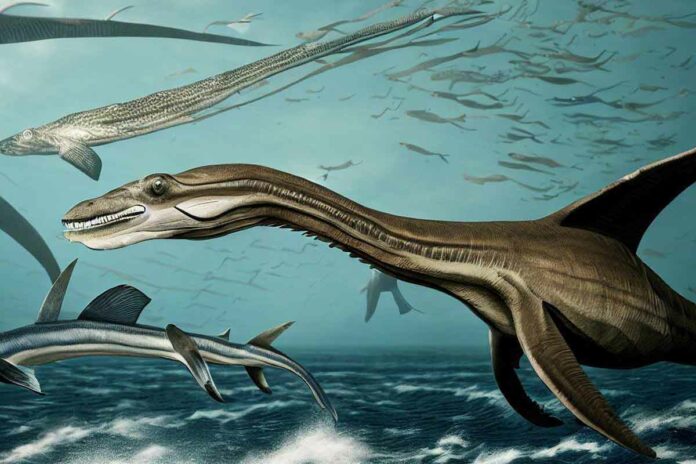A groundbreaking discovery in paleontology has unveiled the remarkable secrets of the earliest ancestors of today’s dolphins.
Meet Olympicetus thalassodon, a fascinating new species of toothed whale that roamed the North Pacific coastline approximately 28 million years ago.
This extraordinary find, described in a recent study published in the open access journal PeerJ Life and Environment, sheds light on the ancient history and diversification of modern dolphins, porpoises, and other toothed whales.
Puerto Rican paleontologist Dr. Jorge Velez-Juarbe from the Natural History Museum of Los Angeles County led the research team responsible for this significant breakthrough.
Unveiling a New Species
"Olympicetus thalassodon and its close relatives possess a unique combination of features that distinguishes them from any other group of toothed whales. The presence of multi-cusped teeth, symmetric skulls, and forward-positioned nostrils makes them resemble an intermediate stage between archaic whales and the familiar dolphins we know today," explains Dr. Velez-Juarbe, Associate Curator of Marine Mammals at NHMLAC.
The study not only introduced Olympicetus thalassodon but also unveiled the remains of two other closely related odontocetes.
All the fossils were unearthed from the Pysht Formation, a geological unit exposed along the coast of Washington State’s Olympic Peninsula.
These remarkable specimens, estimated to be between 26.5 and 30.5 million years old, provide crucial insights into the early evolution of toothed whales.
The Ancient Family of Simocetidae
Dr. Velez-Juarbe’s research further revealed that Olympicetus and its close relatives belonged to a family known as Simocetidae.
This family, known exclusively from the North Pacific, represents one of the earliest diverging groups of toothed whales.
The Pysht Formation, where the fossils were found, housed a diverse array of ancient fauna.
Alongside simocetids, the formation also contained plotopterids (flightless, penguin-like birds), enigmatic desmostylians (early relatives of seals and walruses), and toothed baleen whales.
The Quirky Dental Features
Differences in body size, teeth, and feeding-related structures suggest that simocetids employed various forms of prey acquisition and potentially had distinct dietary preferences.
"The teeth of Olympicetus are truly peculiar, displaying what we call heterodont dentition, with variations along the tooth row," remarks Dr. Velez-Juarbe.
"This starkly contrasts with the teeth of more advanced odontocetes, which are simpler and tend to look almost identical."
Unraveling Echolocation Abilities
While the study has unveiled many remarkable aspects of these early toothed whales, certain aspects of their biology remain shrouded in mystery.
One intriguing question is whether they possessed the ability to echolocate, like their modern counterparts.
Some cranial features indicate the presence of structures associated with echolocation, such as a melon.
A previous study had suggested that neonatal individuals might have been unable to hear ultrasonic sounds.
To further unravel this mystery, future investigations will focus on studying the earbones of subadult and adult individuals to determine whether their hearing capabilities changed as they matured.
The discovery of Olympicetus thalassodon and its relatives has opened up new avenues of exploration into the ancient origins of toothed whales.
With their unique combination of features and peculiar dental characteristics, these remarkable creatures provide invaluable insights into the fascinating evolutionary history of today’s beloved dolphins and porpoises.
The tireless work of scientists like Dr. Jorge Velez-Juarbe continues to illuminate the mysteries of our planet’s past, allowing us to better comprehend the wondrous diversity of life that has flourished throughout the ages.
FAQ
Olympicetus thalassodon is a newly discovered species of toothed whale that lived approximately 28 million years ago along the North Pacific coastline. It represents one of the earliest ancestors of modern dolphins and porpoises.
Olympicetus thalassodon was discovered by Dr. Jorge Velez-Juarbe, a paleontologist from the Natural History Museum of Los Angeles County. Dr. Velez-Juarbe led the research team responsible for this significant find.
Olympicetus thalassodon possesses a unique combination of features that distinguish it from other toothed whales. It exhibits multi-cusped teeth, symmetric skulls, and forward-positioned nostrils, making it resemble an intermediate stage between ancient whales and modern dolphins.
The fossils of Olympicetus thalassodon, along with those of its closely related odontocete relatives, were found in the Pysht Formation. This geologic unit is located along the coast of Washington State’s Olympic Peninsula.
The Pysht Formation is an important site for paleontologists as it has yielded a diverse array of fossils from various ancient marine creatures. These include flightless birds called plotopterids, early relatives of seals and walruses known as desmostylians, toothed baleen whales, and now the ancient toothed whales, including Olympicetus thalassodon.
Olympicetus thalassodon and its close relatives belong to a family called Simocetidae. Simocetids represent one of the earliest diverging groups of toothed whales and are known exclusively from the North Pacific.
The dental features of Olympicetus thalassodon are quite unique. Its teeth display what scientists refer to as heterodont dentition, with variations along the tooth row. This distinguishes it from more advanced odontocetes, whose teeth are simpler and tend to look similar.
The study has not definitively determined whether Olympicetus thalassodon had echolocation abilities. Some cranial features suggest the presence of structures associated with echolocation, such as a melon. Further research is required, including the study of earbones from different age groups, to better understand their hearing capabilities.
The research on Olympicetus thalassodon and its relatives provides valuable insights into the early evolution and diversification of toothed whales, including dolphins and porpoises. These findings contribute to our understanding of the fascinating history of these marine mammals and the diversity of life that existed millions of years ago.
More Information: JOURNAL PeerJ, DOI 10.7717/peerj.15576

